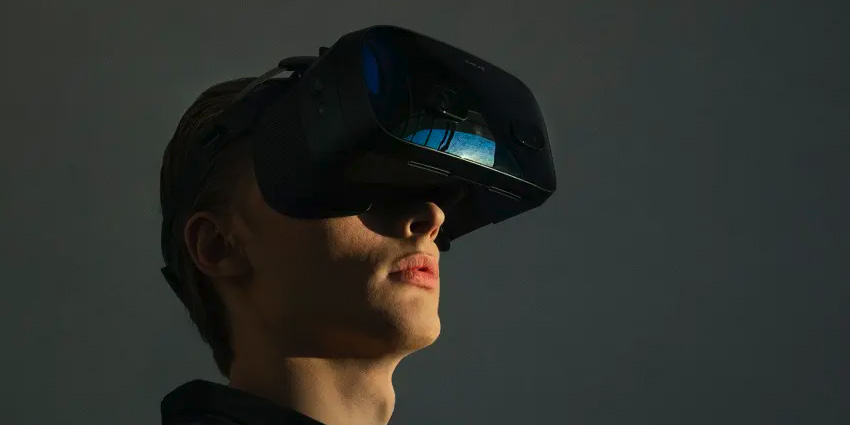Haptic feedback is among the earliest technologies to try and bridge the gap between human and digital interactions by recreating the feeling of vibrations, touch, and pressure to send subtle signals to users.
An example of haptic feedback is when a person long presses a smartphone’s touch screen to activate a feature, and the screen recognizes the gesture with a slight vibration.
Today, with the rise of immersive technologies and the Metaverse, haptic feedback has gained fresh momentum. One can use the technology in all sorts of disruptive use cases, from full-body haptic suits to haptic wrist controllers that help in hands-free Metaverse navigation.
What Is Haptic Feedback Technology?
Haptic feedback is the process of communicating with users through the sensory experience of touch, vibrations, motions, or the perceived application of force and pressure. It recreates the way we interact with the world around us.
For instance, when we press a button on a keyboard, the key vibrates and applies a mild pressure on our fingertips to let us know that we have pressed the correct spot.
The sensory experience of pushing a heavy object is different from that of pushing a light object, not only due to the force it requires, but also because of the difference in force feedback from the action.
Without haptics, there would be no way to distinguish one touch experience from another, diminishing ability to navigate the worl. TmIt complements hand controllers, eye tracking systems, and voice commands, with an interaction system that actively recognizes and validates our inputs.
It complements hand controllers, eye tracking systems, and voice commands, with an interaction system that actively recognizes and validates a user’s inputs.
How Does Haptic Feedback Work?
There are two kinds of touches that human beings experience: passive touch and active touch. In the former, there is no real recognition of the item we are touching. It happens when we absentmindedly turn the pages of a book or touch the chair or table in our work environment while focusing on other matters. In contrast, active touch is when the touch conveys a unique piece of information to our brain, which converts into a feedback signal.
Based on the results and built-in rules or algorithms, the system decides the type of feedback that the touch requires. The feedback is communicated to the surface, which also serves as the output interface.
The user receives the feedback, in a fraction of a second from when the touch was initiated, and knows that the input was registered.
Examples of Haptic Feedback in Use
There are many examples of the use of haptic feedback in both immersive and non-immersive technologies:
Haptics Haptic TactSuit
TactSuit is a full-body suit comprising a vest with embedded haptic feedback points. It has over 40 haptic points placed in strategic positions to provide users with constant feedback as they navigate VR worlds. For instance, in VR gameplay, it will allow users to accurately estimate their position in relation to other objects.
Apple’s Taptic Engine
Apple introduced a haptic engine called Taptic, which would provide the company’s device users with haptic feedback. The Apple watch used this technology to offer a functional input-output mechanism within the device’s limited real estate. All Apple devices with 3D touch use this engine.
Razer Nari Ultimate Haptic Headset
Razer’s premium wireless gaming headset uses haptics to power a feature called HyperSense. It recognizes the shape and frequencies of game audio and transforms them into haptic vibrations, just like in the real world. Users can detect the direction, force, and other dimensions of sound to increase in-game awareness.
Meta’s haptic wrist controllers
Meta Platforms Inc is developing haptics technologies of its own with two prototypes in the works, Bellowband and Tasbi, which will allow users to make complex gestures with their wrists and receive feedback through air pressure. Another project, called ReSkin, aims to recreate realistic feedback using haptic gloves as users interact with virtual objects with Meta’s low-cost, open-source technology platform.
Benefits of Haptic Feedback
There are several reasons why haptics continues to be so popular and companies are investing in further innovations in this space.
It naturalizes virtual interactions – When users receive feedback from their surroundings, VR worlds feel more ‘alive’ and organic and interactions more natural.
It provides an alternative input mechanism – Haptic controllers like wrist bands provide an alternative to traditional handheld VR controllers. This is useful when users’ hands are occupied, in gameplay, remote support, etc.
It eases the learning curve for VR – Since active touch is a part of real-world physics, it is easier to learn than synthetic gesture systems.
It allows VR developers to make use of existing research – Researchers have been working on haptics since the 1960s and 70s, and there is a large body of knowledge to inform future innovations.
It increases interaction accuracy – Haptics feedback decreases the chance of errors when providing inputs. For instance, a haptic touch keyboard is more accurate than a regular touchscreen.
It enhances user satisfaction – The technology increases satisfaction levels by providing users with validation for every input.
What’s Next for Haptic Feedback?
Haptic feedback technology will be crucial to the development of the Metaverse for active users. Right now, metaverse platforms are witnessing a lot of investment, with events and enterprises deploying VR use cases.
Gaming continues to be the primary use for the platforms, but this will change with time with advancements in robotics and remote collaboration.
The Metaverse is poised to become a one-stop destination for online activity, just like social media two decades ago. At that time, interaction systems like infinite scrolling completely revolutionized how we experience the digital world, and similarly, haptic feedback will soon make its way into hand controllers, headsets, wrist bands, bodysuits, omnidirectional treadmills, and other peripherals to help navigate the Metaverse more effectively.






